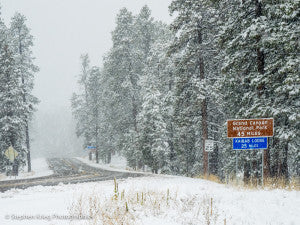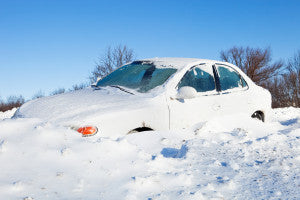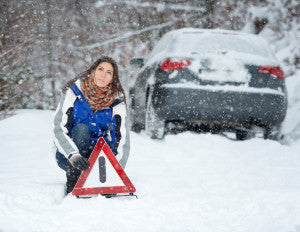[caption id="attachment_21349" align="alignright" width="300"]

45 miles from the North Rim - Photo via Stephen Krieg Photographics[/caption]
A sheriff’s official called it a “Christmas miracle.” On December 23 and 24,
rescuers found a family that got stuck and then separated while trying to drive to the North Rim of the Grand Canyon, which was closed for the winter.
The Klein family, of New Jersey, did some winter survival things well to survive their adventure, according to news coverage. They also made some mistakes that could have caused a tragic ending.
The Kleins were willing to take an alternate route to get to their destination on December 22 when
the primary route was closed. That, and the way father Eric Klein and 10-year-old son Isaac spent the night in the car, suggests they had enough fuel in the vehicle.
“Never let your gas tank get below half,” said AAA Utah spokesperson Rolayne Fairclough. “In winter weather, if you’re detoured, you’ll have some flexibility, and you don’t have to worry about running out of gas.”
The Forest Service road on which the Klein family got stuck didn’t have cell coverage. So the family agreed to have mother Karen Klein, a marathoner and triathlete who’d had some survival training, walk to the main road and get help. A few hours after she didn’t return, Eric walked the other way and found a high spot with enough cell coverage
to call for help. That suggests they kept a cell phone charged.
“Have a cell phone charger system so you have communications,” Fairclough said.
“Don’t fail to signal for help, often and vigorously. Fire, smoke, and mirrors are good signals. Having a charged cell phone is a better one. Time is precious in a survival ordeal, so use it wisely to provide for your basic needs and be sure to signal at every opportunity,” wrote Tim MacWelch, a survival instructor,
in a story for Outdoor Life.
Karen Klein told “Good Morning America” she put snow in her cheek to keep hydrated. At least she didn’t swallow it frozen.
“Don’t eat ice or snow,”
MacWelch warned. It can cause hypothermia. MacWelch suggested filling a bottle with snow or ice and putting it close to, but not next to, your skin, so body heat can melt it.
Karen also stayed awake.
"I just talked to myself and rocked back to stay warm,"
she told reporters.

Even if you’re in a car, stay awake, especially when the engine is running,
according to the North Dakota Department of Transportation.
If you run the car engine, only run it 15 minutes every hour and keep the tailpipe clear of snow to prevent carbon monoxide poisoning. Also, keep windows cracked to avoid running out of oxygen.
Karen Klein admitted they could have avoided this ordeal if they’d planned better.
"As far as places being closed, we just didn't realize that these roads were closed and these visitor centers were closed,"
she told NBC News. "We didn't investigate that deeply."
The main road to the North Rim, State Route 67, was closed.
"Google Maps shows there's a way -- but it's impassable," Jim Driscoll, chief deputy for Coconino County,
told the Associated Press, adding, "This is a problem we've had numerous times."
During winter travel, stay on main roads, urges Ready.gov.
“Avoid back road shortcuts,” the site urges. Tell someone where you’re going, your route, and expected arrival time.
“If your car gets stuck along the way, help can be sent along your predetermined route,”
Ready.gov said.

When you’re stranded, stay close to your vehicle. The
North Dakota Department of Transportation even suggests if you need to leave your vehicle, tie yourself to it with rope.
Karen told NBC News she set out with only Cheerios to eat.
Make sure you’ve got an emergency kit, Fairclough said.
Keep cold weather gear like blankets or a sleeping bag, boots, a coat and gloves in the car, she said. Aluminum “space blankets” can fit in a glove compartment.
Bring a power source for cell phones, a radio and a flashlight with extra batteries.
Believe it or not, a candle can heat a whole car’s cabin, she said. Keep matches too, because extreme cold can freeze some lighters.
Add water and high-energy food like candy, raisins, nuts, dehydrated and
freeze-dried fruit, and jerky. Remember toilet paper.
Finally, take tools and equipment for the car: signaling equipment like bright cloth or flares, chains, booster cables, a nylon rope and a shovel, sand or kitty litter for traction.
In a pinch, you can use the car’s floor mats for traction, Fairclough said.
“A lot of people just don’t put a shovel in their cars,” she admitted.
The Kleins’ trip could have ended in disaster. Coconino County, Ariz., Sheriff Jim Driscoll
told the Los Angeles Times that in the last month, three people in the county died from exposure.
The family did some things right, and emergency responders from many agencies responded quickly. They survived. But their errors could have cost them their lives.
“It can be a pretty hostile environment,”
Driscoll told the Times.

 45 miles from the North Rim - Photo via Stephen Krieg Photographics[/caption]
A sheriff’s official called it a “Christmas miracle.” On December 23 and 24, rescuers found a family that got stuck and then separated while trying to drive to the North Rim of the Grand Canyon, which was closed for the winter.
The Klein family, of New Jersey, did some winter survival things well to survive their adventure, according to news coverage. They also made some mistakes that could have caused a tragic ending.
The Kleins were willing to take an alternate route to get to their destination on December 22 when the primary route was closed. That, and the way father Eric Klein and 10-year-old son Isaac spent the night in the car, suggests they had enough fuel in the vehicle.
“Never let your gas tank get below half,” said AAA Utah spokesperson Rolayne Fairclough. “In winter weather, if you’re detoured, you’ll have some flexibility, and you don’t have to worry about running out of gas.”
The Forest Service road on which the Klein family got stuck didn’t have cell coverage. So the family agreed to have mother Karen Klein, a marathoner and triathlete who’d had some survival training, walk to the main road and get help. A few hours after she didn’t return, Eric walked the other way and found a high spot with enough cell coverage to call for help. That suggests they kept a cell phone charged.
“Have a cell phone charger system so you have communications,” Fairclough said.
“Don’t fail to signal for help, often and vigorously. Fire, smoke, and mirrors are good signals. Having a charged cell phone is a better one. Time is precious in a survival ordeal, so use it wisely to provide for your basic needs and be sure to signal at every opportunity,” wrote Tim MacWelch, a survival instructor, in a story for Outdoor Life.
Karen Klein told “Good Morning America” she put snow in her cheek to keep hydrated. At least she didn’t swallow it frozen.
“Don’t eat ice or snow,” MacWelch warned. It can cause hypothermia. MacWelch suggested filling a bottle with snow or ice and putting it close to, but not next to, your skin, so body heat can melt it.
Karen also stayed awake.
"I just talked to myself and rocked back to stay warm," she told reporters.
45 miles from the North Rim - Photo via Stephen Krieg Photographics[/caption]
A sheriff’s official called it a “Christmas miracle.” On December 23 and 24, rescuers found a family that got stuck and then separated while trying to drive to the North Rim of the Grand Canyon, which was closed for the winter.
The Klein family, of New Jersey, did some winter survival things well to survive their adventure, according to news coverage. They also made some mistakes that could have caused a tragic ending.
The Kleins were willing to take an alternate route to get to their destination on December 22 when the primary route was closed. That, and the way father Eric Klein and 10-year-old son Isaac spent the night in the car, suggests they had enough fuel in the vehicle.
“Never let your gas tank get below half,” said AAA Utah spokesperson Rolayne Fairclough. “In winter weather, if you’re detoured, you’ll have some flexibility, and you don’t have to worry about running out of gas.”
The Forest Service road on which the Klein family got stuck didn’t have cell coverage. So the family agreed to have mother Karen Klein, a marathoner and triathlete who’d had some survival training, walk to the main road and get help. A few hours after she didn’t return, Eric walked the other way and found a high spot with enough cell coverage to call for help. That suggests they kept a cell phone charged.
“Have a cell phone charger system so you have communications,” Fairclough said.
“Don’t fail to signal for help, often and vigorously. Fire, smoke, and mirrors are good signals. Having a charged cell phone is a better one. Time is precious in a survival ordeal, so use it wisely to provide for your basic needs and be sure to signal at every opportunity,” wrote Tim MacWelch, a survival instructor, in a story for Outdoor Life.
Karen Klein told “Good Morning America” she put snow in her cheek to keep hydrated. At least she didn’t swallow it frozen.
“Don’t eat ice or snow,” MacWelch warned. It can cause hypothermia. MacWelch suggested filling a bottle with snow or ice and putting it close to, but not next to, your skin, so body heat can melt it.
Karen also stayed awake.
"I just talked to myself and rocked back to stay warm," she told reporters.
 Even if you’re in a car, stay awake, especially when the engine is running, according to the North Dakota Department of Transportation.
If you run the car engine, only run it 15 minutes every hour and keep the tailpipe clear of snow to prevent carbon monoxide poisoning. Also, keep windows cracked to avoid running out of oxygen.
Karen Klein admitted they could have avoided this ordeal if they’d planned better.
"As far as places being closed, we just didn't realize that these roads were closed and these visitor centers were closed," she told NBC News. "We didn't investigate that deeply."
The main road to the North Rim, State Route 67, was closed.
"Google Maps shows there's a way -- but it's impassable," Jim Driscoll, chief deputy for Coconino County, told the Associated Press, adding, "This is a problem we've had numerous times."
During winter travel, stay on main roads, urges Ready.gov.
“Avoid back road shortcuts,” the site urges. Tell someone where you’re going, your route, and expected arrival time.
“If your car gets stuck along the way, help can be sent along your predetermined route,” Ready.gov said.
Even if you’re in a car, stay awake, especially when the engine is running, according to the North Dakota Department of Transportation.
If you run the car engine, only run it 15 minutes every hour and keep the tailpipe clear of snow to prevent carbon monoxide poisoning. Also, keep windows cracked to avoid running out of oxygen.
Karen Klein admitted they could have avoided this ordeal if they’d planned better.
"As far as places being closed, we just didn't realize that these roads were closed and these visitor centers were closed," she told NBC News. "We didn't investigate that deeply."
The main road to the North Rim, State Route 67, was closed.
"Google Maps shows there's a way -- but it's impassable," Jim Driscoll, chief deputy for Coconino County, told the Associated Press, adding, "This is a problem we've had numerous times."
During winter travel, stay on main roads, urges Ready.gov.
“Avoid back road shortcuts,” the site urges. Tell someone where you’re going, your route, and expected arrival time.
“If your car gets stuck along the way, help can be sent along your predetermined route,” Ready.gov said.
 When you’re stranded, stay close to your vehicle. The North Dakota Department of Transportation even suggests if you need to leave your vehicle, tie yourself to it with rope.
Karen told NBC News she set out with only Cheerios to eat.
Make sure you’ve got an emergency kit, Fairclough said.
Keep cold weather gear like blankets or a sleeping bag, boots, a coat and gloves in the car, she said. Aluminum “space blankets” can fit in a glove compartment.
Bring a power source for cell phones, a radio and a flashlight with extra batteries.
Believe it or not, a candle can heat a whole car’s cabin, she said. Keep matches too, because extreme cold can freeze some lighters.
Add water and high-energy food like candy, raisins, nuts, dehydrated and freeze-dried fruit, and jerky. Remember toilet paper.
Finally, take tools and equipment for the car: signaling equipment like bright cloth or flares, chains, booster cables, a nylon rope and a shovel, sand or kitty litter for traction.
In a pinch, you can use the car’s floor mats for traction, Fairclough said.
“A lot of people just don’t put a shovel in their cars,” she admitted.
The Kleins’ trip could have ended in disaster. Coconino County, Ariz., Sheriff Jim Driscoll told the Los Angeles Times that in the last month, three people in the county died from exposure.
The family did some things right, and emergency responders from many agencies responded quickly. They survived. But their errors could have cost them their lives.
“It can be a pretty hostile environment,” Driscoll told the Times.
When you’re stranded, stay close to your vehicle. The North Dakota Department of Transportation even suggests if you need to leave your vehicle, tie yourself to it with rope.
Karen told NBC News she set out with only Cheerios to eat.
Make sure you’ve got an emergency kit, Fairclough said.
Keep cold weather gear like blankets or a sleeping bag, boots, a coat and gloves in the car, she said. Aluminum “space blankets” can fit in a glove compartment.
Bring a power source for cell phones, a radio and a flashlight with extra batteries.
Believe it or not, a candle can heat a whole car’s cabin, she said. Keep matches too, because extreme cold can freeze some lighters.
Add water and high-energy food like candy, raisins, nuts, dehydrated and freeze-dried fruit, and jerky. Remember toilet paper.
Finally, take tools and equipment for the car: signaling equipment like bright cloth or flares, chains, booster cables, a nylon rope and a shovel, sand or kitty litter for traction.
In a pinch, you can use the car’s floor mats for traction, Fairclough said.
“A lot of people just don’t put a shovel in their cars,” she admitted.
The Kleins’ trip could have ended in disaster. Coconino County, Ariz., Sheriff Jim Driscoll told the Los Angeles Times that in the last month, three people in the county died from exposure.
The family did some things right, and emergency responders from many agencies responded quickly. They survived. But their errors could have cost them their lives.
“It can be a pretty hostile environment,” Driscoll told the Times.



1 comment
Kathy Casey
Though people frequently laugh at me for it, when I travel, particularly in the winter, I have enough supplies in my vehicle to live for at least a week. I have snow boots and clothing, sleeping bags and blankets, food and water, candles and matches in a metal can, a small cook stove and fuel, shovel and other tools, gun and ammo, knives, flashlight, tarp and rope, toilet paper, paper towels and Kleenex. I was stranded in a blizzard once, just over night around Williams, AZ in a 1967 mustang. Slept comfortably with my little daughter and dog until we could resume travel the next day.